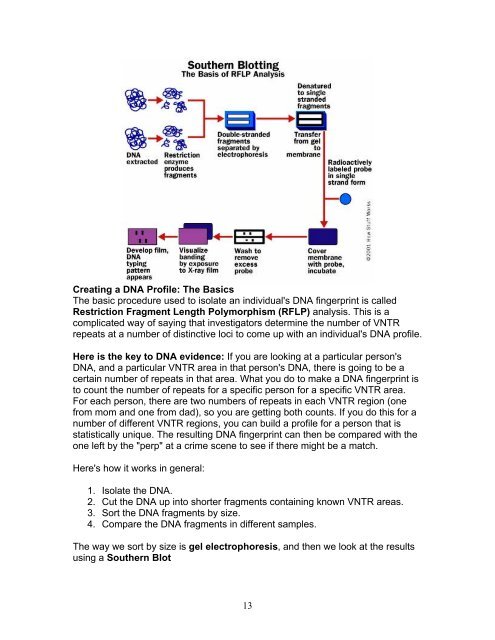Investigating CSI – Background material Table of Contents I ...
Investigating CSI – Background material Table of Contents I ...
Investigating CSI – Background material Table of Contents I ...
You also want an ePaper? Increase the reach of your titles
YUMPU automatically turns print PDFs into web optimized ePapers that Google loves.
Creating a DNA Pr<strong>of</strong>ile: The Basics<br />
The basic procedure used to isolate an individual's DNA fingerprint is called<br />
Restriction Fragment Length Polymorphism (RFLP) analysis. This is a<br />
complicated way <strong>of</strong> saying that investigators determine the number <strong>of</strong> VNTR<br />
repeats at a number <strong>of</strong> distinctive loci to come up with an individual's DNA pr<strong>of</strong>ile.<br />
Here is the key to DNA evidence: If you are looking at a particular person's<br />
DNA, and a particular VNTR area in that person's DNA, there is going to be a<br />
certain number <strong>of</strong> repeats in that area. What you do to make a DNA fingerprint is<br />
to count the number <strong>of</strong> repeats for a specific person for a specific VNTR area.<br />
For each person, there are two numbers <strong>of</strong> repeats in each VNTR region (one<br />
from mom and one from dad), so you are getting both counts. If you do this for a<br />
number <strong>of</strong> different VNTR regions, you can build a pr<strong>of</strong>ile for a person that is<br />
statistically unique. The resulting DNA fingerprint can then be compared with the<br />
one left by the "perp" at a crime scene to see if there might be a match.<br />
Here's how it works in general:<br />
1. Isolate the DNA.<br />
2. Cut the DNA up into shorter fragments containing known VNTR areas.<br />
3. Sort the DNA fragments by size.<br />
4. Compare the DNA fragments in different samples.<br />
The way we sort by size is gel electrophoresis, and then we look at the results<br />
using a Southern Blot<br />
13


